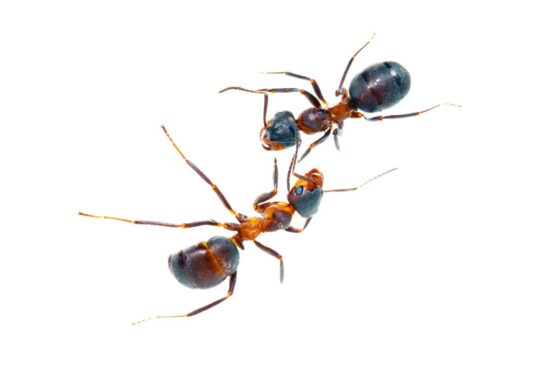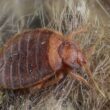Nobody wants to step into their bathroom and see a line of tiny ants marching across the floor. Unfortunately, bathrooms are like ant magnets because they have everything these little pests need: water, warmth, and sometimes food. Learning how to get rid of ants in your bathroom can feel overwhelming, but with the right approach, you can win this battle.
Ants love bathrooms for several reasons. The moisture from showers and sinks gives them the water they need to survive. Hair, soap scum, and toothpaste residue provide food sources. Plus, all those small cracks around pipes and windows make perfect entry points. The good news is that getting rid of ants in the bathroom is totally doable when you know what methods work best.
This guide covers some great ways to eliminate ants from your bathroom, from simple cleaning tricks to professional treatments. Some methods work right away, while others take time to destroy the whole colony. The key is using several methods together for the best results.
1. Deep Clean and Remove All Food Sources
The first step in how to get rid of ants in your bathroom starts with a thorough cleaning. Ants might seem picky, but they’ll happily munch on soap residue, toothpaste drops, hair, and dead skin cells that collect in your bathroom.
Start by cleaning every surface you can reach. Scrub your sink, bathtub, shower, and countertops with soap and water. Don’t forget the areas behind your toilet and under your sink where grime builds up. These hidden spots often have the most ant food.
Pay special attention to anywhere toothpaste might have dripped or soap has left a film. Even tiny amounts of these substances can attract dozens of ants. Clean out your medicine cabinet, wipe down bottles, and make sure no sticky residue remains on any containers.
Make this deep cleaning a regular habit. Wipe down surfaces every day after use, and do a thorough cleaning once a week. This simple step removes the food sources that bring ants into your bathroom in the first place.
Use a mild detergent or mix equal parts water and white vinegar for your cleaning solution. Both work well and are safe around your family and pets.
2. Eliminate Moisture and Fix Water Leaks
Ants need water to survive, so getting rid of ants in the bathroom means cutting off their water supply. Check every faucet, pipe, and fixture for leaks. Even a tiny drip can provide enough water for an entire ant colony.
Look under your bathroom sink for wet spots or water damage. Check around your toilet base and in your shower area. If you find any leaks, fix them right away. Tighten loose connections and replace worn washers or gaskets.
Humidity is another big problem. After you shower, turn on the exhaust fan and leave it running for at least 30 minutes. If you don’t have a fan, open a window to let moisture escape. Wipe down wet surfaces with a towel instead of letting them air dry.
Consider using a small dehumidifier if your bathroom stays humid even with good ventilation. Keep humidity levels below 50% when possible. Ants thrive in moist environments, so a dry bathroom is your best defense.
Make sure your shower drain works properly and doesn’t allow water to pool. Standing water anywhere in your bathroom will attract ants and other pests.
3. Seal All Entry Points and Cracks
Ants are incredibly small and can squeeze through the tiniest openings. Walk around your bathroom with a flashlight and look for any cracks or gaps where ants might enter.
Check around your windows and door frames first. Look at the caulking around your bathtub and shower. Examine the areas where pipes enter through walls or floors. Even hairline cracks in tile grout can serve as ant highways.
Use clear silicone caulk to seal small cracks and gaps. For larger openings, you might need expanding foam or other materials. Pay extra attention to the space where your toilet meets the floor, as this is a common ant entry point.
Don’t forget about electrical outlets and switch plates. Remove the covers and check for gaps that need sealing. Replace old weather stripping around windows and doors if it’s cracked or missing.
This sealing work might take some time, but it’s one of the most effective ways to keep ants out permanently. Check your sealing job every few months and touch up any areas that have developed new cracks.
4. Use Natural Repellents (Essential Oils and Vinegar)
Natural repellents can be very effective for getting rid of ants in the bathroom without using harsh chemicals. These methods work by disrupting the scent trails that ants use to navigate and communicate with each other.
Peppermint oil is one of the best natural ant deterrents. Mix about 10 drops of peppermint essential oil with a cup of water in a spray bottle. Spray this mixture along ant trails, around entry points, and anywhere you’ve seen ant activity. The strong smell will keep ants away.
White vinegar works similarly well. Mix equal parts white vinegar and water in a spray bottle. Spray it on ant trails and wipe down surfaces where ants have been walking. The vinegar erases their scent trails and makes it harder for other ants to follow.
Tea tree oil is another powerful natural repellent. Use it the same way as peppermint oil. You can also try lemon essential oil or even fresh lemon juice mixed with water.
Ground cinnamon sprinkled around entry points can also deter ants. The strong smell confuses their navigation system and keeps them from entering your bathroom.
Remember that natural repellents need to be reapplied regularly since the scents fade over time. Use these methods along with other treatments for the best results.
5. Apply Diatomaceous Earth
Food-grade diatomaceous earth is a natural powder that can kill ants without using toxic chemicals. This fine powder is made from fossilized algae and works by damaging the ants’ outer shell, causing them to dry out and die.
You can buy food-grade diatomaceous earth at most hardware stores or online. Make sure you get the food-grade version, not the kind used for pool filters, which can be harmful.
Sprinkle a thin layer of diatomaceous earth along ant trails and around areas where you’ve seen ants entering your bathroom. Focus on cracks, corners, and anywhere ants seem to travel regularly.
The powder works best when it’s dry, so don’t apply it to wet surfaces. If it gets wet from cleaning or humidity, you’ll need to reapply it. Wear gloves when handling diatomaceous earth and avoid breathing in the dust.
This method takes time to work since ants have to walk through the powder to be affected. You might see results within a few days, but it could take up to a week to notice a significant reduction in ant activity.
Diatomaceous earth is safe around children and pets when you use the food-grade version, making it a good choice for families who prefer natural pest control methods.
6. Set Up Borax-Based Ant Baits
Ant baits are one of the most effective ways to eliminate entire ant colonies. Borax-based baits work because worker ants carry the poisoned food back to their nest, where it kills the queen and other ants you never see.
To make a liquid bait, mix 2 tablespoons of borax with 2 tablespoons of sugar and 1 cup of warm water. Stir until everything dissolves completely. Soak cotton balls in this mixture and place them along ant trails and near entry points.
For a paste bait, mix 3 parts peanut butter with 1 part borax. This protein-based bait attracts different types of ants than sugar baits do. Place small amounts on bottle caps or pieces of cardboard.
Keep these baits away from children and pets since borax can be harmful if eaten. Place them in areas where ants travel but where curious kids and animals can’t reach them.
Be patient with bait stations. It might take several days or even weeks to see results because the bait needs time to reach the entire colony. Don’t use ant sprays near your bait stations since the chemicals can repel ants and prevent them from taking the bait.
Replace the baits if they dry out or get contaminated. Fresh bait is always more attractive to ants.
7. Use Commercial Ant Bait Stations
If you prefer ready-made solutions, commercial bait stations can be very effective for how to get rid of ants in your bathroom. These products contain professional-strength baits that are often more attractive to ants than homemade versions.
Look for bait stations that contain ingredients like fipronil, hydramethylnon, or indoxacarb. Popular brands include Terro, Maxforce, and Advion. These products are designed to be tamper-resistant, making them safer around children and pets.
Place bait stations along ant trails and near entry points, but not directly on the trail where ants are walking. Ants will find nearby bait stations and prefer them over random food sources.
Use both sweet-based and protein-based baits if possible. Different ant species prefer different types of food, so variety increases your chances of success. Some ants prefer sugar and others want grease or protein.
Check your bait stations regularly and replace them according to the package directions. Most need replacement every few months or when the bait is gone.
Commercial bait stations often work faster than homemade baits because they’re specifically designed to be irresistible to ants. They’re also more convenient since you don’t have to mix anything yourself.
8. Apply Ant Spray for Immediate Knockdown
Sometimes you need quick results when dealing with an ant problem. Ant sprays can kill ants on contact and provide temporary control while your other treatments start working.
Choose an indoor ant spray that’s labeled for bathroom use. Look for products containing pyrethroid insecticides, which are effective against ants but break down quickly indoors. Spray directly on ant trails and around entry points.
Residual sprays last longer than contact sprays. These products leave a coating that continues to kill ants for several weeks after application. Apply them to areas where ants travel but avoid spraying on surfaces you touch regularly.
Never spray ant killer near your bait stations. The chemicals can repel ants and prevent them from taking the bait back to their colony. Use sprays and baits in different areas of your bathroom.
Follow all label directions carefully and make sure the area has good ventilation when you’re spraying. Keep children and pets out of the treated area until the spray dries completely.
Remember that sprays only kill the ants you can see. They won’t eliminate the colony, so use them along with baits and other methods for complete control.
9. Vacuum Ants and Nests
Vacuuming is a simple but effective way to remove ants immediately and disrupt their activities. Use a vacuum with strong suction and a crevice tool attachment to reach into corners and cracks where ants hide.
Vacuum along ant trails to remove both the ants and the scent trails they leave behind. Pay attention to areas around your toilet base, under your sink, and anywhere you’ve seen ant activity.
If you can locate the ant nest, vacuum it thoroughly. Indoor nests are often found in wall voids, under floors, or in other hidden areas near heat and moisture sources.
Empty your vacuum bag or canister immediately after vacuuming ants. Put the contents in a sealed plastic bag and throw it away outside your home. Some ants might still be alive and could escape back into your house.
For extra protection, add a small amount of water or bleach to your vacuum canister before vacuuming. This will kill any ants that survive the vacuuming process.
Vacuuming works best as part of a complete treatment plan. It removes ants quickly but won’t prevent new ones from entering your bathroom.
10. Clean Drains and Eliminate Buildup
Bathroom drains can harbor food particles, moisture, and organic matter that attracts ants. Some species even build nests in drain areas, making drain cleaning an important part of getting rid of ants in the bathroom.
Pour equal parts baking soda and white vinegar down your drains. You’ll see foaming action that helps break up buildup and kill bacteria. Wait until the foaming stops, then flush with hot water to wash everything away.
Clean your drain covers regularly to remove hair, soap scum, and other debris. Use an old toothbrush to scrub away stubborn buildup around the drain opening.
Consider using drain covers or stoppers when you’re not using your sink or tub. This prevents ants from entering through the drain and reduces the moisture that attracts them.
If your drains are slow or clogged, fix the problem promptly. Standing water and organic buildup create perfect conditions for ants and other pests.
Do this drain cleaning monthly to prevent ant problems before they start. Clean drains are less attractive to ants and reduce the overall pest pressure in your bathroom.
11. Improve Ventilation and Air Circulation
Good ventilation reduces the humidity that attracts ants to bathrooms in the first place. Proper air circulation also helps surfaces dry faster, eliminating the moisture ants need to survive.
Use your exhaust fan every time you shower or take a bath. Run it for at least 30 minutes after you finish to remove all the excess moisture from the air. If your fan is noisy or doesn’t work well, consider upgrading to a more powerful model.
Open windows when weather permits to let fresh air circulate through your bathroom. Even a few minutes of fresh air can help reduce humidity levels significantly.
If your bathroom doesn’t have an exhaust fan, consider having one installed. It’s one of the best investments you can make for preventing ant problems and other moisture-related issues.
Check that your existing ventilation system is working properly. Clean the fan and ductwork if necessary. Blocked or dirty vents don’t move air effectively.
Some bathrooms benefit from additional air circulation fans or dehumidifiers, especially in humid climates. These devices help maintain the dry conditions that make your bathroom less attractive to ants.
12. Call Professional Pest Control
Sometimes DIY methods aren’t enough, and you need professional help with how to get rid of ants in your bathroom. Pest control experts have specialized knowledge, tools, and products that aren’t available to regular homeowners.
Consider calling professionals if you’ve tried multiple methods for 2-3 weeks without success. Large infestations or recurring ant problems often need professional treatment to eliminate hidden colonies.
Carpenter ants are another reason to call experts immediately. These large ants can cause structural damage to your home by tunneling through wood. Professional identification and treatment are essential for carpenter ant problems.
Pest control professionals can identify the exact species of ants in your bathroom. Different species need different treatment approaches, and experts know which methods work best for each type.
Professional treatments often include perimeter applications around your home’s foundation. These barriers prevent new ants from entering while interior treatments eliminate existing colonies.
Many pest control companies provide guarantees and follow-up services. If ants return within a certain time period, they’ll treat your home again at no extra cost.
Get quotes from several companies and ask about their experience with bathroom ant problems. Choose a company that explains their treatment plan clearly and uses methods you’re comfortable with.
Conclusion
Getting rid of ants in the bathroom requires a combination of cleaning, moisture control, sealing, and targeted treatments. No single method works perfectly on its own, but using several approaches together can eliminate even stubborn ant problems.
Start with basic prevention measures like cleaning and moisture control, then add baits or natural repellents as needed. For serious infestations, don’t hesitate to call professional pest control experts who can provide specialized treatments.
Remember that patience and persistence are essential for long-term success. Some methods take time to work, especially baits that need to reach the entire colony. Stick with your treatment plan and maintain good prevention habits to keep ants out of your bathroom for good.
With the right approach and consistent effort, you can win the battle against bathroom ants and enjoy a clean, pest-free space.


